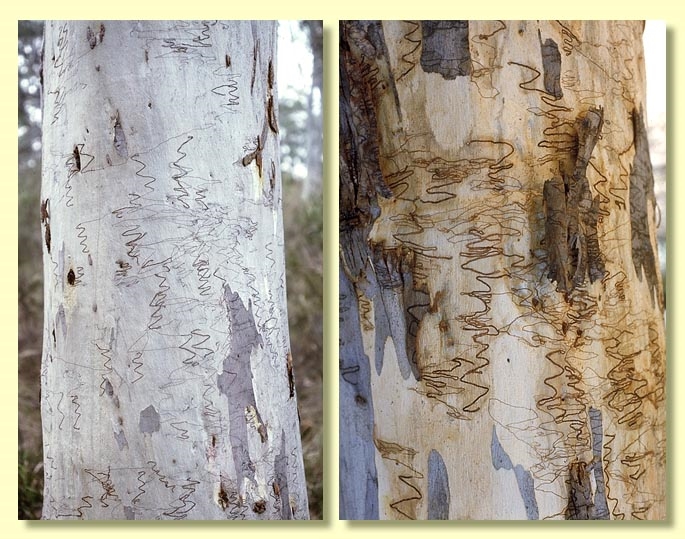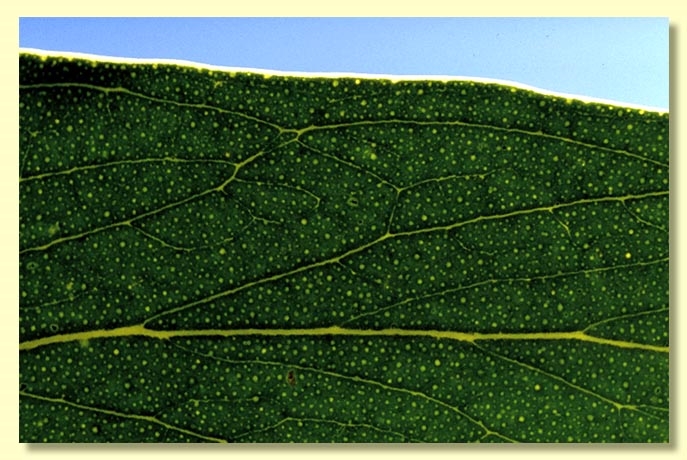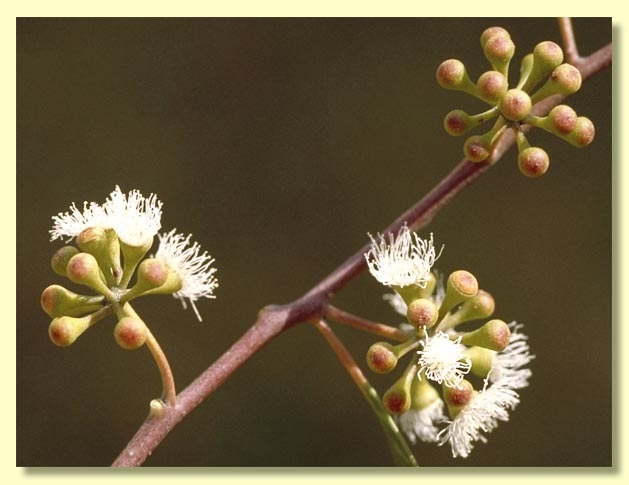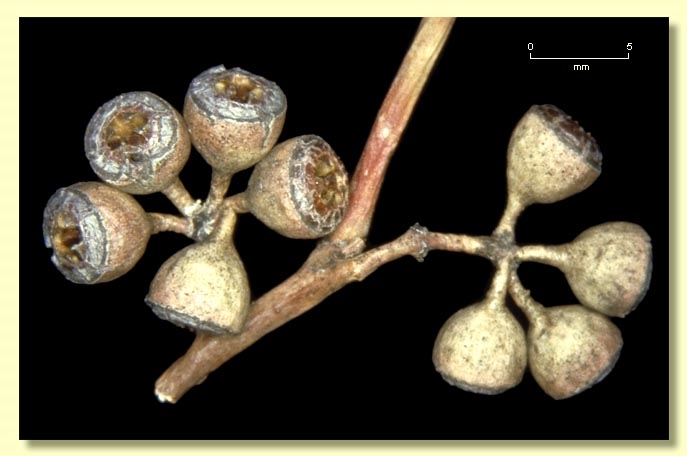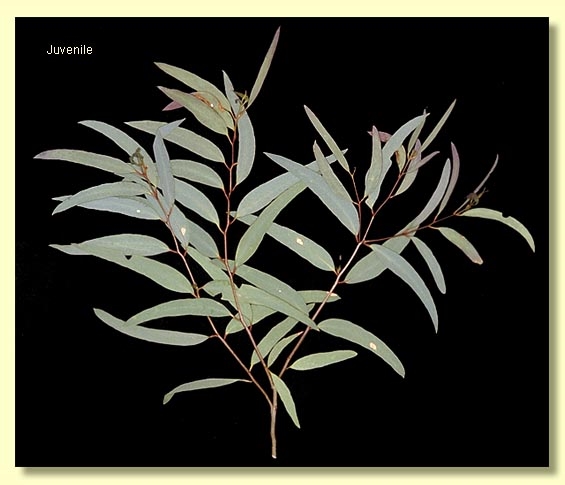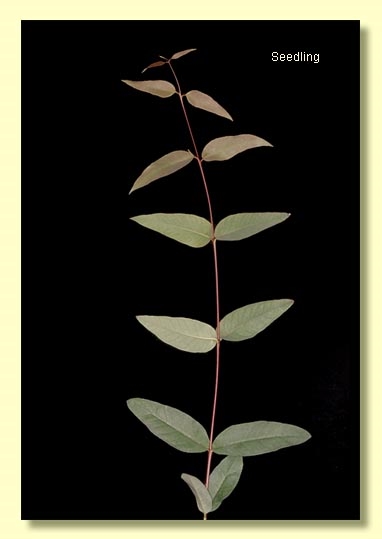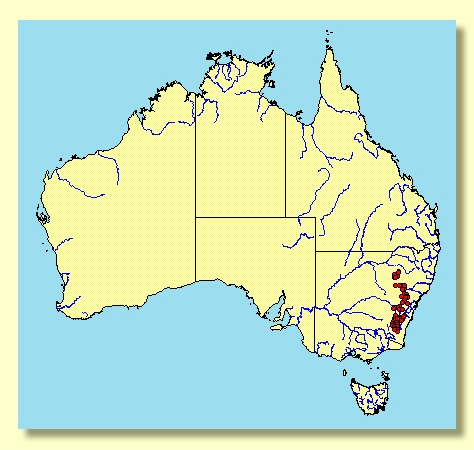Euclid - Online edition
Eucalyptus racemosa subsp. rossii
Eucalyptus | Eucalyptus | Cineraceae | Psathyroxylon | Haemastomae
Eucalyptus rossii R.T.Baker & H.G.Sm., Res. Eucalypts 70 (1902). T: Cow Flat, Bathurst, NSW, Mar. 1901, R.T.Baker s.n.; holo: NSW (missing); Bungendore, NSW, March 1899, Baker & Smith s.n. ; lectotype: NSW, (fide Pfeil & Henwood, 2004).
Bark smooth, rarely powdery, silvery white, cream, pale grey, orange-yellow, with scribbles.
Juvenile growth (coppice or field seedlings to 50 cm): stem rounded in cross-section, warty or smooth; juvenile leaves sessile at first then shortly petiolate, opposite for 6 to 8 pairs becoming alternate, lanceolate to narrowly lanceolate or falcate, 7–14 cm long, 1.5–4 cm wide, base rounded or tapering, dull, green to blue-green.
Adult leaves alternate, petiole 0.7–2 cm long; blade narrowly lanceolate to lanceolate, 5.5–15 cm long, 0.8–2.5 cm wide, base tapering to petiole, concolorous, glossy or dull, green to blue-green, side veins acute, sparsely reticulate, intramarginal vein parallel to and well removed from margin, oil glands island.
Inflorescence axillary unbranched, or sometimes terminal compound, peduncles 0.7–1.1 cm long, buds 9 to ?15 per umbel, pedicels 0.3–0.6 cm long. Mature buds obovoid, 0.3–0.5 cm long, 0.2–0.3 cm wide, green to yellow, scar absent, operculum rounded, stamens inflexed, with outer staminodes, anthers reniform to cordate, versatile, dorsifixed, dehiscing by confluent slits, style short, stigma tapered, locules 3 or 4, the placentae each with 2 vertical ovule rows. Flowers white.
Fruit pedicellate (pedicels 0.3–0.6 cm long), cup-shaped, hemispherical or truncate-globose, 0.3–0.6 cm long, 0.4–0.6 cm wide, disc slightly raised-convex to annular or level, reddish brown, valves 3 or 4, near rim level.
Seeds brown to reddish brown, 0.8–2 mm long, pyramidal or obliquely pyramidal, dorsal surface smooth, hilum terminal.
Cultivated seedlings (measured at ca node 10): cotyledons reniform to orbicular; stems rounded in cross-section, warty or smooth; leaves ± sessile to shortly petiolate, ovate-elliptic and opposite for 6 to 10 nodes then alternate, and conspicuously petiolate, ovate-lanceolate, 5.5–12 cm long, 1.5–3.5 cm wide, rounded then tapering, margin entire, apex pointed, concolorous, dull, grey-green to green.
Flowering has been recorded in January, February, September, October, November and December.
Eucalyptus racemosa is a species of small to medium-sized trees widespread in New South Wales from Jervis Bay to Albury and north through coast, tableland and western slope regions to Gympie and Bundaberg in south-eastern Queensland. Eucalyptus racemosa has completely smooth bark whitish becoming yellow in late spring when old bark is shed, glossy or dull adult leaves with sparsely reticulate venation and small buds arranged either in the axils of leaves or terminal to the branchlet. The smooth bark usually has conspicuous scribble marks left by larvae of moths of the genus Ogmograptis.
Eucalyptus racemosa is one of two completely and uniformly smooth-barked scribbly-gum species, the other being the New South Wales endemic species, E. haemastoma of the Central Coast. Eucalyptus racemosa differs from E. haemastoma in having fruit 0.3–0.6 cm wide, whilst the latter has fruit 0.7–1.1 cm wide.
There are two subspecies:
E. racemosa subsp. racemosa
Has a more coastal distribution from Nowra, New South Wales, north to near Bundaberg in Queensland. It has broader juvenile leaves, but with some overlap in dimensions; adult leaves generally less than 7.5 times as long as wide.
E. racemosa subsp. rossii
Occurs on the Tablelands and Western Slopes of New South Wales from Bombala and near Albury north to Pilliga, Warialda and Tenterfield, not quite into Queensland, nor into Victoria. It has narrower juvenile leaves, but with some overlap in dimensions; adult leaves usually more than 7 times as long as wide.
The small fruited white gum Eucalyptus mannifera subsp. mannifera often grows with and can be confused with E. racemosa subsp. rossii but the two differ in the following field characters that are easily assessed: E. mannifera subsp. mannifera has adult leaves with moderate to dense leaf venation and lacks scribbles on the bark contrasting with E. racemosa subsp. rossii which has sparse leaf venation and scribbly bark.
In the classification of Brooker (2000) Eucalyptus racemosa belongs in Eucalyptus subgenus Eucalyptus section Cineraceae series Psathyroxylon having the following characters: cotyledons reniform, juvenile leaves alternate, bluish, adult leaves with side-veins acute, single axillary inflorescences with buds in clusters of seven to 15, buds with single operculum, inflexed stamens, some outer stamens without anthers (staminodes), the remainder with reniform anthers, style short, ovules in two rows, and seeds more or less pyramidal. Within series Psathyroxylon the two scribbly gums E. haemastoma and E. racemosa form subseries Haemastomae.
We include two other species that have been in recent usage, E. sclerophylla and E. signata, in synonymy with E. racemosa as the distinctions are more or less negligible. This view is shared by Bean (1997) and Pfeil & Henwood (2004).
subsp. rossii: after William John Clunies Ross (1850–1914). Clunies Ross entered the teaching service of New South Wales at Bathurst in 1885. In 1904 he was appointed Lecturer-in-Charge, Department of Chemistry and Metallurgy at the Sydney Technical College. When Baker and Smith described this species in 1902 in Research on the Eucalypts, especially in Regard to the Essential Oils, they wrote that the eucalypt had been named in honour of Mr. Clunies Ross 'who has rendered material help in procuring specimens for the research'.


